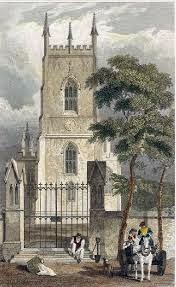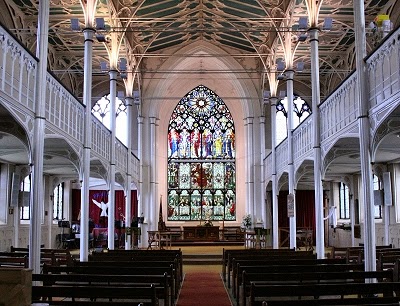St Georges Everton.
Everton was once a
suburb of Liverpool and in the 1820's hat had a setting of what we
would now think of as picture postcard.
Thomas Rickman, St
Georges architect did not start out as an architect he had a journey
that led him to design buildings that was quite unusual.
He was a pharmacist and
a surgeon and also worked in the corn trade.
 When he lent money to
a friend who could not pay it back, he left his home town of
Maidenhead and came to Liverpool looking for work in 1807.
When he lent money to
a friend who could not pay it back, he left his home town of
Maidenhead and came to Liverpool looking for work in 1807.
After his second wife
and their daughter died he seems to have been free to drift into
different studies. Weather, geology, gas lighting, steam boats and
drawing all got his attention. He may have been what we would now
say, on the autistic spectrum, he was a meticulous accounts keeper.
He painted and catalogued a whole army of toy soldiers probably lead.
Collecting engravings
he began to study architecture and he studied and recorded Gothic
churches and their ruined state.
In 1812 he delivered a
series of lectures and was elected professor of architecture at the
Liverpool Academy.
His friend Thomas Cragg
owned the Mersey Iron Foundry and waxed lyrical about the use of cast
iron in architecture.
Rickman sketched
architectural details such as windows door frames and balustrades for
him.
As simply as two
friends talking Rickman began to draw a cast iron church, they were
kindred spirits in design. His designs at this stage it could be said
were not quite top work and were stiff in design. This was an early
stage of iron construction.
Mr Atherton had
promised £12,000 for the building of a church on the site of the old
Liverpool lighthouse and on 29th December 1812 a public
meeting was called.
This proved a master
stroke as Mr Atherton gave the commission to the pair on the
understanding that the exterior be built in stone and the interior be
erected in cast iron.
This enabled them to
pre fabricate the structure and bolt it together on-site.
One commentator stated
that the structure 'exhibited a very marked advance upon anything
previously attempted in Liverpool-the tone character and motif of
every part being derived from a careful study of ancient examples'.
Gothic architecture at
the time had a wide breadth ranging from Norman to Henry VIII.
Some Gothic structures
were a derision of classical wrapped up in a confused fusion of many
differing styles.
Iron was cutting edge
at the time and when we analyse it, there appears to be that the
medieval oak and stone ribs of ancient times were being replaced by
slender columns of iron.
With an ease of
construction this was being explored well ahead of Ruskin's eloquent
dissecting of Iron's pros and cons and how it would fit into the
modern forms of construction in his Seven Lamps of Architecture.
The challenge in the
blending of the old with the new is something we now take for granted
as it all looks old now but the debate would be intense.
Rickman began to
publish papers in Liverpool showing his understanding of his work
that were to be inspiring to others.
An attempt to
discriminate the styles of English architecture from the Conquest to
the Reformation, proceeded by a sketch of the Grecian and Roman
Orders, with notes on nearly 500 English Buildings was published
in 1817.
Years later Ferguson
was to write ' by a simple and easy classification Rickman reduced to
order what before was simple chaos to all minds'.
So the Gothic was born
of Rickmans work and was championed by Augustus Welby Northmore
Pugin.
Cragg
also built St Micheals in 1814 with even more iron used. Many of the
mouldings were from St Georges. The exterior is of brick. Parapets
and finials of iron. It was called “the cast iron church”. St
Philips in Hardman Street followed in 1816. From these three
buildings stems the seed of the prefabricated cast iron church and
the onset of mass production so from this little acorn of an idea
buildings were shipped all over the world. Some sections could be
replicated over and over again, and from a single mould.
At
a time of great expansions in cities nationwide it came at a very
convenient time to produce quickly churches for the masses. This need
was combined by the “Million pound Act” to get ecclesiastical
buildings erected quickly to educate the masses coming in from the
fields no doubt.
Rickman
worked with John Foster junior on a commission for St Martins which
is no longer standing.
Foster
was not a purveyor of the Gothic style.
I did not realise when
as a young boy, along with the rest of the class, as we were led into
the church like little lambs, silent lambs, from the side directly
adjacent to the school of St Georges how important it was.
It was a solid
building that wrapped around you with protective care, friendly and
self assured, we didn't know we were poor.
The play of light
through the bejewelling of the stained glass with its storytelling
panels was always designed to bring you to a subservient situation.
The torch of coloured beams searching, and finding you, in between
the columns of pews. I still remember to this day my first sighting
of the interior of St Georges with the angelic sound of choristers
raising your spirit, bringing you closer to what you were told to
believe in. Those pointed arches and the fine and light decorated
tracery. I did not know I was in one of the most important churches
in the country. I remember my neighbour staring up at me and winking
to me as I showered him and his newly married wife with a handful of
confetti from the roof of the exterior porch. I remember the
christening of my cousins and the crying over the font when touched
with that holy water from within.

 I don't know if these
memories that are torched into my mind are what made me understand
that even in poverty you can still look up to the stars, and even
though we were poor we were in the middle of an area of St Georges
plateau that had great care and fine workmanship bestowed upon it.
I don't know if these
memories that are torched into my mind are what made me understand
that even in poverty you can still look up to the stars, and even
though we were poor we were in the middle of an area of St Georges
plateau that had great care and fine workmanship bestowed upon it.
Most
of the stained glass was destroyed in the Second World War survivor
is a window dated 1863 by A. Gibbs. The glass in the east window
dates from 1952 and is by Shrigley and Hunt.
The
original chair frame bell was made by Ainsworth of Warrington. It was
restored in 1937 by George Eccles but vandalised in the late 1960s.
The present clock was made by Smiths of Clerkenwell and installed in
1973.
In the next street to
our humble abode was Our Lady's, the beginnings of the church that
was to rival St Peters in Rome. The chancel chapel was built, it was
going to be massive. It was demolished in the 80's, how sad. It was a
Pugin and Pugin design. This was the original site for what Arthur
Dooley christened Paddy's Wigwam. St Georges may have been the most
prominent structure on Liverpool's skyline prior to Gilbert Scott's
Anglican sandstone Cathedral being built. How mariners will have been
thankful to see the sight knowing they were safely home. Probably
having been press ganged in the Baltic Triangle area, which was
renowned for this form of kidnap to keep the seas highways safe for
the British Empire.
There were other Pugin
buildings that had fallen into disrepair, the wash house was a hive
of soapy gargling conversation spun together by the washerwomen
within. It was a social thing.
I would sometimes get
a treat and be given a tanner and go over to the cubicle d public
baths where someone in the next bathtub would sing “My name is Jack
and I live in the Bath” as a take on the hit of the day.
The smell was a
slightly carbolic one, that of cleanliness and running hot water was
a luxury we did not have, nor an inside loo.
Mr Tyson the builder
used to run a boys club in one of the buildings behind the steaming
wash house.
 I did not know we
relied on charity and philanthropists. A caged football pitch was
built in between the school and the house, on St Domingo Road, as
somewhere the kids could play and we played 9 a side football, that
was sometimes a little light on one side depending on how many turned
up.
I did not know we
relied on charity and philanthropists. A caged football pitch was
built in between the school and the house, on St Domingo Road, as
somewhere the kids could play and we played 9 a side football, that
was sometimes a little light on one side depending on how many turned
up.
The Prodi dogs against
the Cats we would all have enough incentive.
It was stupid I know
now. How pathetic it seems now that there was such a monumental
battle still ranging amongst the Popery and King Billy's lot.
It raged all around you
people tried to indoctrinate you at an early age.
Though it did not take
long for me to see through all that religious none-sense
And my church, my
lovely little church was part of that too.


